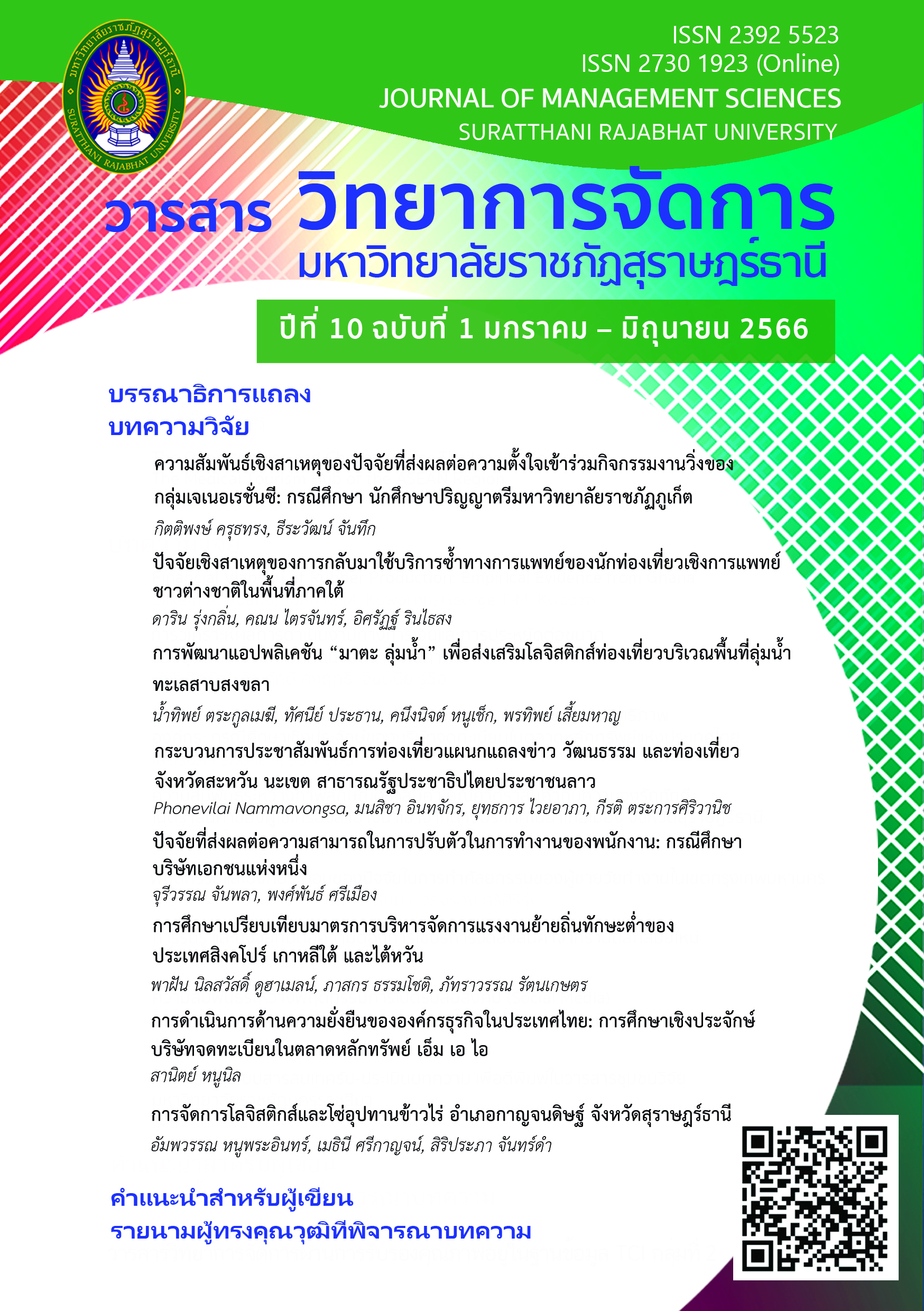Comparative Study on Migrant Worker Management Measure of Singapore, South Korea and Taiwan
Main Article Content
Abstract
International labor mobilization is on an increasing trend. Therefore, each country must have measures to manage and control the influx of workers. This research aimed to: 1) study the measures for the management of low-skilled migrant workers in Singapore, South Korea, and Taiwan; 2) Compare the measures to manage low-skilled migrant workers in Singapore, South Korea, and Taiwan. Documentary studies and in-depth interviews were used to collect data. The sample groups were selected by the head of departments in labor mobilization both in Thailand and overseas and Thai migrant workers, working in the case study’s countries. The results found that measures to manage the low-skilled migrant workers in Singapore, South Korea, and Taiwan, the "Employer-Driven" approach was used to import workers according to the needs of employers. However, to control the quantity and quality of recruiting migrant workers with efficiency and without causing economic, political, and social impacts within the country. All three countries therefore set conditions for the admission of low-skilled migrant workers in various fields, namely: entrance channel, labor qualifications such as age, language skills, and labor skills, employment ceiling, tax on foreign worker employment and employer qualifications. However, such conditions depend on the policy and socio-economic environment of each country.
Article Details

This work is licensed under a Creative Commons Attribution-NonCommercial-NoDerivatives 4.0 International License.
References
Ayuwat, D., Aimimtham S., & Theerawisit, A. (2010). Livehoods of Thai Workers in Taiwan: a Study of Destination. Journal of Humanity and Social Science Khonken, 27(1), 1-28.
Bunmak S., & Chaophanitcharoen, P. (2020). International Migration Policy of Foreign Workers: A Case Study of Immigration and Employment in Taiwan. KKU International Journal of Humanities and Social Sciences, 10 (2), 122-154.
Department of Employment. (2021). Oversea Employment Aboard. http://www.doe.go.th/prd/assets/upload/files/overseas_th/0040b52562415899899af9fbd95474e9.pdf.
Disyatat, P. (2015). Illegal Thai Workers in Republic of Korea. Ministry of Foreign Affairs. Individual Study, International Institute of Devawongsewarophakorn, Ministry of Foreign Affairs.
Equal times. (2020). Will Taiwan reform its system of labour brokerage to better protect migrant workers?. https://www.equaltimes.org/will-taiwan-reform-its-system-of
HRD Thailand (personal communication, January 30, 2022)
G. Sripaurya (personal communication, December 1, 2021)
ILO and UN Women. (2020). Public attitudes towards migrant workers in Singapore December 2020. https://www.ilo.org/wcmsp5/groups/public/---asia/---ro-bangkok/documents/briefingnote/wcms_766633.pdf
Kulkolkarn, K. (2014). Management of Foreign Workers in Thailand and Aboard. The Thailand Research Fund.
Kulkolkarn, K. (2016). Cost-Benefit for Economic of Thai Migrant Worker: A Case Study of Taiwan. Bangkok Bloc: Bangkok.
Kulkolkarn, K. (2019) Illegal Thai Workers in the Republic of Korea : Causes of Problems and Solutions. Journal of Intelligence, 14 (1), 105-121.
Ministry of Manpower, Singapore (n.d.) Work Permit for Migrant Worker. https://www.mom.gov.sg/.
O. Thongboumakrod (personal communication, September 22, 2021)
Office of Labor Affairs, Royal Thai Embassy, Kaohsiung (2021). Guidebook for Thai workers in Taiwan. https://taipei.mol.go.th/wpcontent/uploads/sites/9/2021/01A1-2564.pdf
Office of Labour Affairs, Royal Thai Embassy, Singapore (2016). Singapore Employment Policies and Thai Workers. https://singapore.mol.go.th/news.
Office of Labour Affairs, Royal Thai Embassy, Singapore. (2022). Demand for Thai Labour in Singapore. https://singapore.mol.go.th/situation/trends-and-opportunities-of-thai-workers.
Office of Labour Affairs, Royal Thai Embassy, Seoul. (2018). Labour Market in Republic of Korea. https://korea.mol.go.th/situation/thai-labor-market.
Pinitpuvadol, K., Taweejamsap, S., & Tassanaipitakkul, N. (2016). Migrant Workers. International Institute for Trade and Development.
Rungruekrit, C., Suwanprapa, V., & Sanamchuan S. (2011). A Study on Thai Labour Protection in Taiwan. Thai Human Resource Research Journal, 6 (2), 13-26.
Recruitment Agencies (personal communication, September 1-5, 2021)
S.Laodamrongchai (personal communications, August 22, 2021)
Shimanuki, S. (2021). Financial Inclusion of Migrant Workers in Singapore. Scholarly Commons, 1-20. https://repository.upenn.edu/sire/90.
Srisen, N. (2019) Thai migrants’ Mobility and Illegality in South Korea. Journal of Social Science Chiangmai University, 31(1), 144-170.
Thailand Trade and Economics Office. (2022). Policies and Quotas for Foreign Workers Employment. https://taipei.mol.go.th/situation/trends-and-opportunities-of-thai-workers.
Teng, Y., M. (2014) Singapore’s System for Managing Foreign Manpower Managing International Migration for Development in East Asia. The World Bank Group, 220-240.
T. Singsrida (personal communication, June 18, 2021)
Thai Migrant Workers in Taiwan (personal communication, October 20, 2021)
Thai Migrant Workers (personal communication, October 1-5, 2021)
Thai Migrant Workers in Taiwan, Singapore, South Korea and Labor Recruitment Agencies (personal communication, October 1-15, 2021)
Wongboonsin. (2009) Migration theories and the patterns of the migration situation in Asia. Bangkok: College of Population Studies, Chulalongkorn University.
Workforce Development Agency, Ministry of Labor. (2022). Work Qualifications and Rules for Foreign Workers. https://www.wda.gov.tw/en/NewsFAQ.aspx?n=26470E539B6FA395&sms=0FCDB188C74F69A0
World Bank. (2017). Migrating to Opportunities: Overcoming Barriers to Labor Mobility in Southeast Asia. https://openknowledge.worldbank.org/bitstream/handle/10986/28342/9781464811067.pdf


